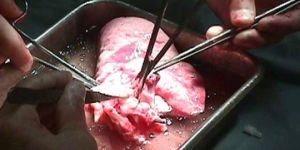GERD-induced Aspiration Appears to Increase Chances of Lung Transplant Failure
There is strong evidence that GERD-induced aspiration helps to cause lung transplant failure, though more research is needed to identify the underlying pathogenic mechanism of injury to the transplanted organ, finds a recent review of studies on the topic.

There is strong evidence that GERD-induced aspiration helps to cause lung transplant failure, though more research is needed to identify the underlying pathogenic mechanism of injury to the transplanted organ, finds a review of studies on the topic. The review, by P. Marco Fisichella, MD; Christopher S. Davis, MD; and Elizabeth J. Kovacs, PhD, of the Loyola University Medical Center, was published online earlier this month in Surgical Endoscopy.
The authors note that the median survival of lung transplant patients is just five years and that failure is most often caused by distal airway fibrosis resulting in obliterative bronchiolitis (OB). Although the pathophysiology of OB is poorly understood, it may be caused by GERD, and several studies have found that the presence of GERD in lung transplant patients is a risk factor for the development of bronchiolitis obliterans syndrome (BOS), the physiological hallmark of OB.
The authors note that the current literature supports a strong association, though not necessarily a causal relationship, between GERD and BOS. A number of studies detailed in the review generally establish that elevated levels of pepsin and/or bile acids in the bronchoalveolar lavage (BAL) of lung transplant patients are associated with development of BOS and with higher levels of acute rejection of the lung allograft.
A study conducted by the authors found that pepsin concentrations were elevated in the BAL of lung transplant patients whether they had reflux or not and were lower in GERD patients who had laparoscopic antireflux surgery (LARS) than in those who did not undergo LARS. In addition, those with detectable pepsin concentrations in their BAL progressed more quickly to BOS than those without. These findings support the hypothesis that pepsin plays a pathogenic role in aspiration-induced lung failure and that LARS can help manage patients threatened by it, but they do not explain the process by which aspiration causes lung allograft injury at the cellular or molecular level or how LARS protects against such injury. However, the authors cite another small study that showed a significant reduction in potentially damaging effector CD8 cells in the BAL fluid after LARS, suggesting that this is the mechanism by which such surgery helps prevent allograft injury.
Pending better understanding of how aspiration may cause lung injury, the authors explain that their practice is to use LARS to stop GERD-induced aspiration after lung transplantation. (LARS is deemed preferable to treatment with proton pump inhibitors, which alter the pH of the refluxate but do not prevent nonacid reflux.) Candidates for LARS are chosen based on positive esophageal pH-monitoring, presence of pepsin in BAL fluid, or evidence of aspiration on transbronchial biopsy.
In sum, the authors write that the evidence seems to strongly support a causal role of GERD-induced aspiration in the development of lung transplant failure and that future research should aim at identifying the underlying pathogenic mechanism of allograft injury.